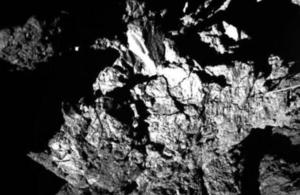UK-led Rosetta instrument successfully sniffed 67P
The preliminary scientific observations of Comet 67P from Rosetta’s Philae lander published in special edition of the journal, Science.

The surface of comet 67P. Credit: ESA.
Highlights from the first scientific analysis of data include:
- complex molecules that could be key building blocks of life
- daily rise and fall of temperature
- assessment of surface properties and internal structure
Data was obtained during the lander’s seven-hour descent to its first touchdown at the Agilkia landing site, which then triggered the start of a sequence of predefined experiments. But shortly after touchdown, it became apparent that Philae had rebounded and so a number of measurements were carried out as the lander took flight for an additional two hours some 100 m above the comet, before finally landing at a site named Abydos.
Some 80% of the first science sequence was completed in the 64 hours following separation before Philae fell into hibernation, with the unexpected bonus that data were ultimately collected at more than one location, allowing comparisons between the touchdown sites.
Ptolemy science
During Philae’s first bounce off of the comets surface, UK-led instrument Ptolemy sampled ambient gas and detected main components of coma gases, including water vapour, carbon monoxide and carbon dioxide. Smaller amounts of carbon-bearing organic compounds were also detected, such as formaldehyde.
Some of the compounds detected by Ptolemy could be the key building blocks of life. Formaldehyde, for example, is implicated in the formation of ribose, which ultimately features in molecules like DNA.
The existence of such complex molecules in a comet, a relic of the early Solar System, imply that chemical processes at work during that time could have played a key role in fostering the formation of prebiotic material.
Ian Wright, Professor of Planetary Sciences at the Open University and Principal Investigator for the Ptolemy instrument, said:
Notwithstanding the bumpy landing, our instrument was in action (and working perfectly!) a few minutes after the initial touchdown, making analyses of compounds from the surface of the comet. We discovered a large signal from an organic polymer rich in carbon, hydrogen and oxygen. We believe that materials like this were probably brought to the surface of the primitive Earth and are likely to have been involved in processes leading to the origin of life.
Rosetta and the UK
With funding from the UK Space Agency and the Science and Technology Facilities Council (STFC), Rosetta is a mission with significant UK involvement from industry and science.
Philae’s instruments include a gas analyser, the Ptolemy instrument, which was designed and built by teams from the UK’s Science and Technology Facilities Council’s RAL Space and the Open University. Ptolemy has an on-board oven for heating comet samples and collects data to analyse the relationship between water ice on comets and the Earth’s oceans. Ptolemy also studies the nature of organic material on the comet and uses this to investigate the relationship with similar materials from other Solar System bodies.
One of the main challenges for all the companies designing instruments for Rosetta has been to ensure the components remain intact for ten years, while the spacecraft makes its way to the comet, and then work perfectly when it gets there.